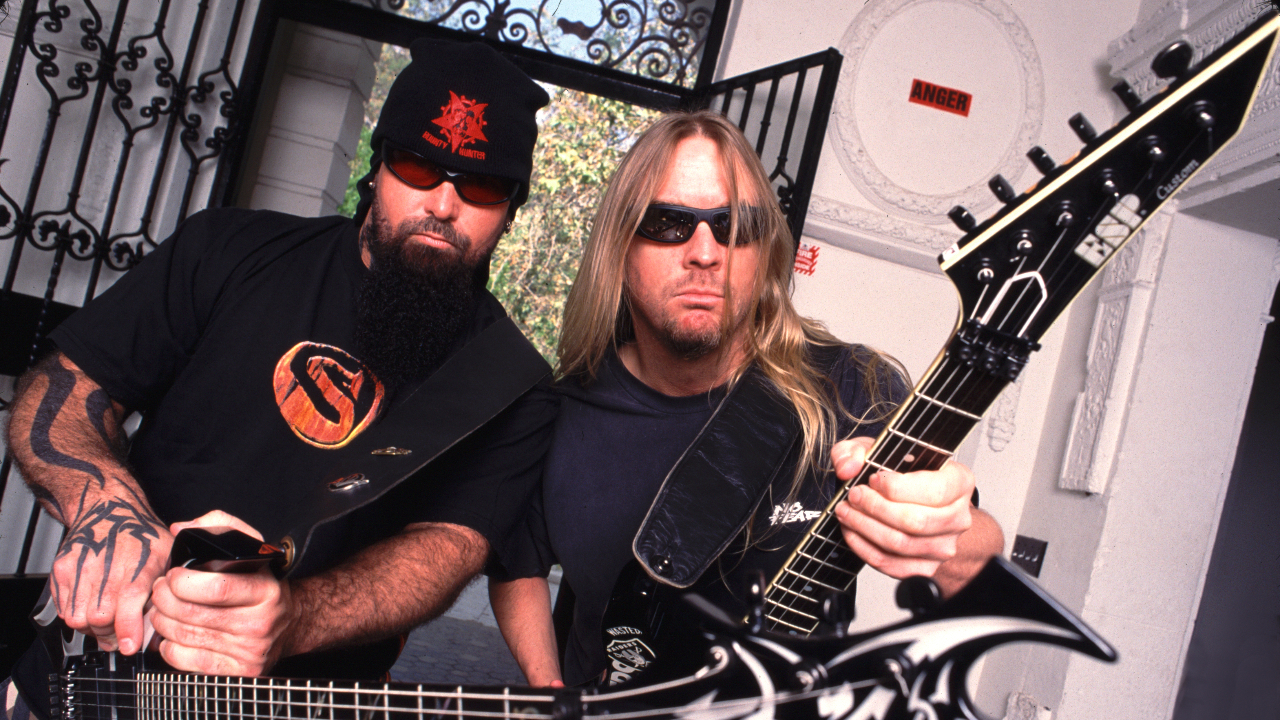“I thought it was frat boy stuff...it's my least favourite record of our history.” The story of thrash metal legends Slayer 'going nu metal' and regretting it almost immediately (and why that album is much better than you remember)
When Slayer began to dabble with contemporary influences in the 90s, it didn't end well for them

In the story of the Big 4 of thrash, the band that is always considered to have stayed truest to the genre is Slayer. Anthrax dabbled with rap metal, Megadeth went for radio-friendly rock, and Metallica...well, you know what happened with Metallica. Even Testament made ballads and Exodus had a groove metal album. Slayer, though, they remained committed to thrash, right? Wrong actually!
Released in 1998, just as nu metal was tightening its grip on the heavy music scene, Slayer’s eighth album is the exception that proves the rule: experimental, groove-laded, down-tuned, featuring rap-esque vocal patterns and basically disowned by the band, Diabolus In Musica is the one true outlier in their back catalogue. The question is, nearly three decades after the event, is it actually any good?
You can’t blame other people for Slayer creating, in guitarist Kerry King’s own words, “my least favourite album of our history”, but as Slayer started the process of writing their first set of new material since 1994’s Divine Intervention, the musical climate around them was not leaving them inspired.
“When we were writing this album, I was looking around for something to beat,” guitarist Jeff Hanneman told Kerrang! magazine in 1998. “But nothing impresses me now. Nothing really sounds really aggressive or heavy enough for me to inspire me to beat it. So, I just had to come up with my own shit.”
Kerry King, in particular, had been especially vocal about his lack of interest in modern rock and metal. One 1996 interview with Metal Hammer, previewing Slayer going into the studio, sees him take shots at Korn’s Life is Peachy, Pantera’s The Great Southern Trendkill and, of course, Metallica’s controversial Load.
“I wasn’t even into making any music for a while there because I was so fucking pissed off with the music business and the music that was out there,” he would tell Kerrang! two years later. “Like The Presidents of the United States of America. What the fuck was that all about? How did they get so popular?”

Slayer on stage at Roskilde 1998

In the end, King’s lack of inspiration led to almost the entirety of Diabolus in Musica being written by Hanneman.
Sign up below to get the latest from Metal Hammer, plus exclusive special offers, direct to your inbox!
“The biggest difference between this record and Divine Intervention was that I wrote a lot of this one,” Hanneman told Metal Hammer. ‘With Divine…, I was in a rut and couldn’t come up with riffs I like. Before I knew it, Kerry had most of it done. So, with this record I really started working hard from the beginning.”
At that time, Slayer seemed to believe they had created an album befitting their stacked back catalogue.
“There are indeed some things done differently,” King told Metal Invader in 1998. “We never had a special groove in our music. We were heavy, we were fast. This time we acquired more groove! We tried it and sounded very good. Tom also tried some new things on vocals. There’s more character.”
“Jeff felt it was like the older Show No Mercy and Hell Awaits stuff,” vocalist Tom Araya told Kerrang! in 1998, adding: “there’s definitely a correlation.”
The album’s name was appropriately evil as well. “The ‘Diabolus in Musica’ was a musical scale which was outlawed in the 1400’s by the church,” Araya explained. “They felt it would bring out the devil in people.”
Diabolus in Musica was due to be released in 1997, but, due to their label American Recordings being purchased by Columbia, it ended up coming out on June 9, 1998, selling an impressive 46,000 copies in its first week and landing at number 31 on the US Billboard Top 200 and number 27 on the UK Album Chart. Happy days, right?
Well, not quite. It’s here that people started to question the “new” Slayer sound. Reviews were initially strong, but the album didn’t seem to stick with fans. The feelings were summed up in a New York Times live review of the band that stated: "Eight of the 11 songs on Diabolus in Musica, a few of which were played at the show, are in the same gray key, and the band's rhythmic ideas have a wearying sameness too."
Soon, the band were being questioned about the album's influences: was this new, groovy Slayer jumping on the nu metal bandwagon?
“Love to Hate is one of those songs on there that people said was kinda nu metal,” drummer Paul Bostaph told Metal Rules in 2007. “I would say Stain of Mind has that kind of hip-hop scratch going on there. If you take them off the record then I don’t hear any other elements of nu metal.”
Despite Bostaph’s proclamations, time was not kind to Diabolus in Musica’s reputation. King later called it the band’s Turbo, in reference to Judas Priest's glammy, divisive 1986 album, and for band and many fans alike, it has been all but forgotten - there's no sign of that era even existing on Slayer's official YouTube channel.
“I thought it was very frat boy stuff, and maybe that's why it was popular, I don't know,” King told Metal Evolution. “Diabolus... didn't get as much attention from me because we didn't stay in focus. Looking back, we were just saying, ‘Alright, how do we make Slayer fit into today's society?’ But that's probably my least favourite record of our history.”
Listening back to Diabolus in Musica today, it would be disingenuous to suggest it is up there with Slayer’s finest work, but to suggest it sounds like Limp Bizkit is going too far the other way.
Sure, Stain of Mind and Love to Hate both have that classic nu metal bounce, and Tom Araya’s vocal patterns are slightly clipped into a rap style, but they also have screeching, squealing Kerry King solos. More crucially, they’re a pair of absolute bangers. Opener Bitter Peace and Screaming from the Sky both start with a groovy riff but are more comparable with Prong or Helmet than Papa Roach. Plus, when you’ve got a song like the pure thrash of Scrum in your arsenal, comparisons with Hybrid Theory seem utterly daft.
So, Diabolus in Musica, then; possibly the fly in the ointment for Slayer’s cred as unshakable thrash metal devotees, but still much better than often given credit for.

Merlin was promoted to Executive Editor of Louder in early 2022, following over ten years working at Metal Hammer. While there, he served as Online Editor and Deputy Editor, before being promoted to Editor in 2016. Before joining Metal Hammer, Merlin worked as Associate Editor at Terrorizer Magazine and has written for Classic Rock, Rock Sound, eFestivals and others. Across his career he has interviewed legends including Ozzy Osbourne, Lemmy, Metallica, Iron Maiden (including getting a trip on Ed Force One courtesy of Bruce Dickinson), Guns N' Roses, KISS, Slipknot, System Of A Down and Meat Loaf. He has also presented and produced the Metal Hammer Podcast, presented the Metal Hammer Radio Show and is probably responsible for 90% of all nu metal-related content making it onto the site.
You must confirm your public display name before commenting
Please logout and then login again, you will then be prompted to enter your display name.
